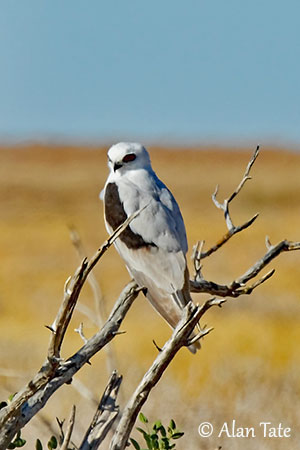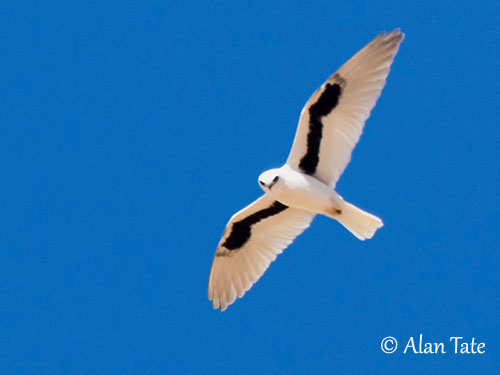
REPRODUCTION OF THIS SPECIES:
The laying season is irregular. It is continuous when prey are abundant following rains, but the breeding activity is much reduced between these periods of abundant food resources.
The Letter-winged Kite breeds in colonies of 20-40 birds, but sometimes up to 100 individuals. It may occasionally nest solitary.
The nest is a platform made with small sticks and twigs, and lined with green leaves, cattle dung, rat fur or regurgitated pellets. It is built in the canopy of live tree, between 2 and 11 metres above the ground. There is very rarely more than one nest per tree, even in colonies. Old nests of ravens may be used too.
The female lays 4-5 dull white eggs with red-brow markings. She incubates probably during 30-31 days. She broods and care the chicks covered first in creamy down, and then in fawn-coloured down.
The male brings food at night for female and chicks. When the food is scarce, the pair abandons both nest and chicks. The young fledge 30-35 days after hatching, but they are still fed by adults for some times.
PROTECTION / THREATS / STATUS:
The Letter-winged Kite is generally rare, with fluctuating numbers making difficult to assess its conservation status.
There are no known major threats, but competition for food with red fox and feral cats might impact the breeding success. Feral cats also attack the nests and take numbers of nestlings.
The population is roughly estimated at 670/6,700 mature individuals.
The species is regarded as secure, but the Letter-winged Kite is currently classified as Near Threatened.
However, biology and ecology of this species are poorly known and more research is needed.
Fr: Elanion lettré
Ang: Letter-winged Kite
All: Schwarzachselaar
Esp: Elanio Escrito
Ita: Nibbio scritto
Nd: Letterwouw
Sd: nattglada
Photographers:
Alan & Ann Tate
AA Bird Photography
Text by Nicole Bouglouan
Sources:
HANDBOOK OF THE BIRDS OF THE WORLD Vol 2 by Josep del Hoyo-Andrew Elliot-Jordi Sargatal - Lynx Edicions - ISBN: 8487334156
BIRDS OF AUSTRALIA by Peter Rowland – Ed: Louise Egerton - ISBN: 1864363436
Field Guide to Australian Birds by Michael Morcombe - Editeur: Steve Parish Publishing Pty Ltd – ISBN-10: 187628210X -ISBN-13: 978-1876282103 - 448 pages
The Graham Pizzey & Frank Knight Field Guide to the Birds of Australia - Publisher: HarperCollins Publishers (Australia) Pty Ltd; Reprint. Edition (1996) - ISBN-10: 020718013X - ISBN-13: 978-0207180132 - 528 pages
The Cornell Lab of Ornithology - Birds of the World
Birds in backyards (Birds Australia and Australian Museum)
Global Raptor Information Network - Working to Conserve Birds of Prey in nature
Australia - State of the Environment
Wikipedia, the free encyclopaedia
Letter-winged Kite
Elanius scriptus
Accipitriformes Order – Accipitridae Family
INTRODUCTION:
The name of the Letter-winged Kite is derived from the black letter-markings on the underwing which resembles M or W when the bird is flying.
This raptor is found in arid regions of Australia. It forages at night and feeds mainly on small rodents. It nests in loose colonies of up to 50 individuals. The nest is a large, cup-shaped structure built among the foliage near tree tops.
The Letter-winged Kite is not globally threatened, but extreme fluctuations of population size make difficult to estimate the numbers. This raptor is highly dependent on populations of Rattus villosissimus which is its main prey. However, the population of the Letter-winged Kite is regarded as secure, but it is currently considered Near Threatened.
DESCRIPTION OF THE BIRD:
Biometrics:
Length: 34-37 cm
Wingspan: 84-89 cm
Weight: 260-310 g
The Letter-winged Kite has pale grey upperparts including upperwing and nape. On the upperwing, we can see a black shoulder patch. The tail is white with pale grey central rectrices.
Head and underparts are white, but the underwing shows black M or W markings, conspicuous in flight and giving the bird its name.
The bill is black with dark grey-brown cere. The eyes are deep red, surrounded by black area, broader on lores. Legs and feet are creamy-white with black talons.
Male and female have similar plumage, but the female is 5% larger and 20% heavier than the male.

The juvenile has a brownish-orange band across forehead, neck and breast. The eyes are dark brown instead of red in adults.
The upperparts and the hindneck are grey-brown with orange tips to upperpart feathers. Rump and central rectrices are pale grey with orange tips.
The Letter-winged Kite resembles a falcon with a large, rounded head. The wings are long and reach beyond the tail tip at rest.
RANGE:
The Letter-winged Kite occurs in the arid interior of Australia in the southern Northern Territory, W Queensland, N South Australia and New South Wales.
Some irruptions are reported, sometimes with nesting in other regions, except in W desert and far NE.
HABITAT:
The Letter-winged Kite usually frequents open country and grasslands in both arid and semi-arid regions of Australia, especially tree-lined streams and water courses. During periods of food abundance, irruptions are reported. The birds may disperse to higher rainfall coastal regions.
The species is visible from sea-level to 1,000 metres of elevation.
CALLS AND SONGS: SOUNDS BY XENO-CANTO
The Letter-winged Kite is usually noisy throughout the year, and not only during the breeding season.
The male gives high, clear whistle as alarm call. The female responds with harsh, rasping “karrr” notes. These calls are also used as contact between pairs and at roots.
Courtship displays are accompanied by loud chattering. Both adults are vocal at nest, usually around food passage by male to female.
BEHAVIOUR IN THE WILD:
The Letter-winged Kite feeds mainly on rodents, especially Rattus villosissimus and Pseudomys australis. These mammals are very abundant after wet periods.
This raptor typically hunts at night, searching for small mammals, but it also takes reptiles and insects. It may sometimes hunt in groups, in pairs or singly.
It forages by quartering, often hovering before to drop onto the prey on the ground. It may sometimes hunt from perch.
However, some birds may forage by day in areas of both very abundant or scarce prey.
During the day, the Letter-winged Kite roosts among the foliage of trees, often in flocks of up to 400 individuals. They start to hunt at dusk.
These raptors perform aerial displays including high flight above the nest. During this behaviour, the male flies much higher than the female. Then, it drops near the female which raises her wings like the male during the flight. Then, both mates circle each other while producing a loud chattering, and copulation follows these displays.
The breeding season is irregular and often depends on food abundance. We don’t know if the pair-bonds remain between the breeding seasons.
The Letter-winged Kite is dispersive and irruptive. This raptor moves and concentrates around rodent abundance, and then, it disperses towards the coast when rodent numbers fall. Immatures may die of starvation if they fail to find prey elsewhere.
The Letter-winged Kite displays the black conspicuous M or W of the underwing when flying. It soars with V-shaped, upcurved wings, while the primaries are slightly spread and the tail fanned. During active flight, the wingbeats are interspersed with long glides on angled wings. It can be seen hovering motionless facing into the wind while beating the wings.
